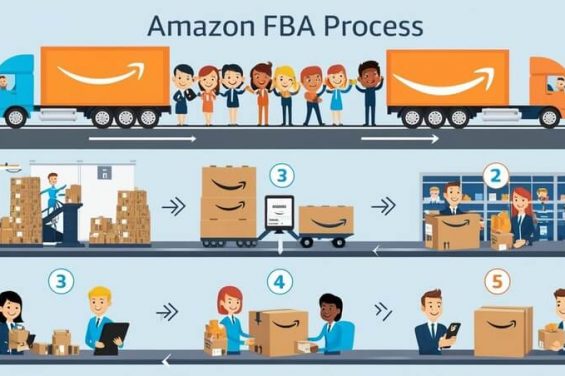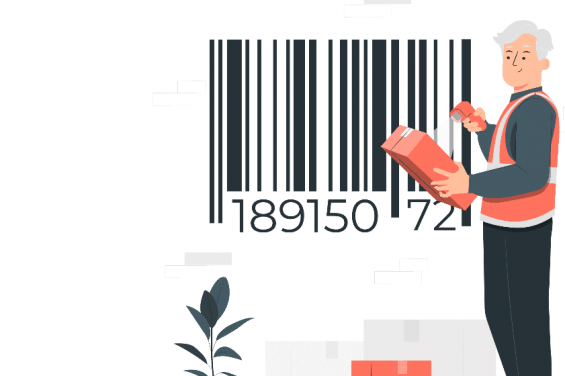This is a complete guide to Amazon packaging requirements.
In this in-depth guide, you’ll learn:
- How to explain complex Amazon FBA packaging requirements to your suppliers
- How to explain customs and international transportation requirements to your suppliers
- Lots more valuable tips and tricks
So, if you’re ready to go “all in” with Amazon’s packaging requirements, you are in the right place.
Let’s dive right in.
Why Your Suppliers Done Wrong Packaging
Improper Amazon product packaging may result in shipment damage, extra fees, or even rejection of your goods by Amazon. Nevertheless, some suppliers provide Amazon sellers with inadequate packaging.

Because:
- They supply other people who are not Amazon sellers. Therefore, they pay more attention to the quality of their products than the packaging
- They have shorter risk delivery points than you, according to Incoterms. In most cases, they are responsible for ensuring that the goods are safely delivered to your forwarder. However, you must ensure that the goods are safe for consumers to receive
- They get little or no benefit from the preparation and packaging of products
Making sure your supplier easily understands Amazon’s packaging requirements is of extreme importance.
Amazon Product Packaging & Labeling Requirements
When it comes to complex FBA product packaging and labeling requirements, it’s easy to get overwhelmed. But don’t worry, we’ll make them easy to understand.

Product Packaging Requirements for Amazon FBA
Over 12 million products are sold on Amazon. Amazon can’t standardize a single product packaging requirement for all FBA merchandise. Based on the packaging and shipping requirements of the product, the platform has divided products into various categories with different requirements.
Polybag Products
Generally, polybags are one of the most popular packaging materials due to their cost-effectiveness.
1) The types of polybags
- Ziplock bags: are also known as self-seal or resealable bags and can be used for packaging many products, including jewelry, cosmetics, stationary, and loose products
- Bubble bags: are generally used to protect fragile objects. Bubble bags with adhesive strips are best
- Vacuum bags: are used for packaging clothing, comforters, linen, pillows, and other fabrics, saving space and shipping costs. They are also useful for packaging plastic plates. When several plastic plates are packaged together, vacuum packaging saves space and prevents them from rubbing against one another during shipping
- Shrink wrap bags: are often used for packaging books, and shoes.
2) The requirements for polybags:
- Thickness: The poly bag must be at least 1.5 mils (0.0015 inches or 0.0381 mm). By the way, most polybags are between 1-6 mils thick
- Color: Most Amazon FBA products are packaged in transparent polybags, except adult products which must be packaged in black or opaque polybags
- Required label: A suffocation warning must be printed or labeled in a prominent place on the polybag if the polybag is 5 inches (12.5 cm) or larger
- Quality: Polybags must be of good quality and stay in good condition during transportation
3) How to package a polybag product
- Do: The polybags are sealed well
- Don’t: The polybags are not sealed well
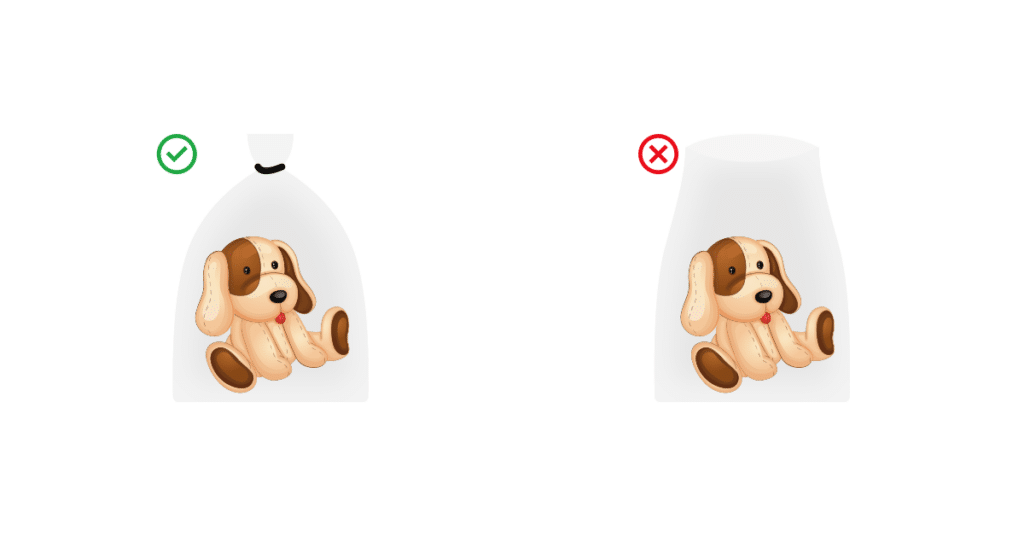
Box Products
Boxes are also a popular packaging material due to their safety and charm.
1) The types of product boxes
There are multiple styles of folding cartons or boxes available for packaging products. Plus, the box material is usually single-layered paperboard, and two layers of cardboard paper .
- Straight tuck boxes are suitable for lightweight and medium-weight goods
- Lock bottom boxes are ideal for heavier items such as coffee cups and glass jars
- One-piece tuck top boxes are ideal for large items or Sold As Set items such as shoes and a set of toys
- Two-piece boxes accommodate many products, including cosmetics, shoes, and electronic products. However, please note that Amazon only accepts two-piece boxes that are sealed or wrapped with a heat-shrink wrap
| Straight Tuck Box | Lock Bottom Box | Tuck Top Box | Two-Piece Box |
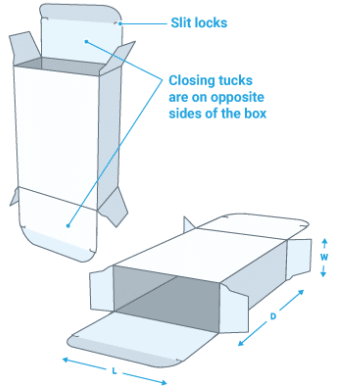 | 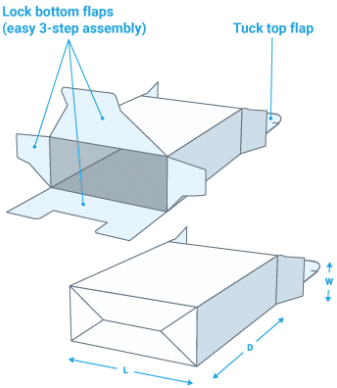 | 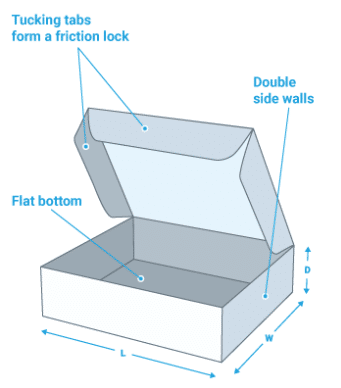 | 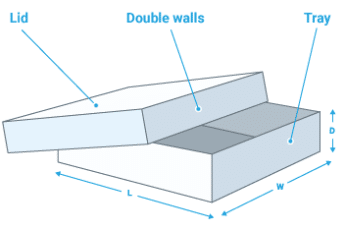 |
2) The requirements for boxes
- Type: Square or rectangular boxes
- Opening: Boxes’ openings are difficult to open by themselves
- Quality: Product boxes must be high quality and remain in good condition during transportation
Tip: Don’t choose undersized boxes which are difficult to label or easy to cover important information.
3) How to package box products
- Do: The product boxes are totally sealed
- Don’t: The product boxes are not sealed well
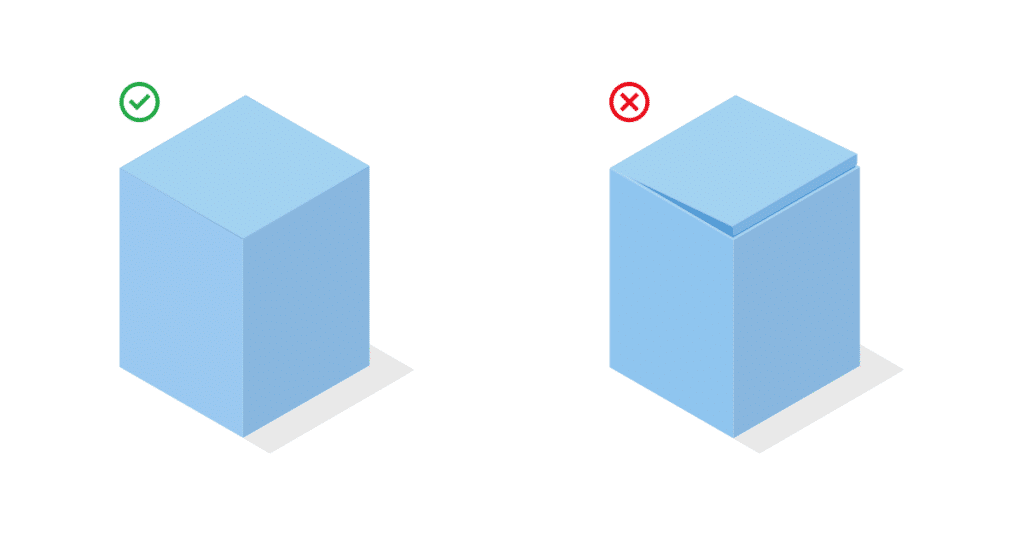
Fragile Products
Fragile products include glass items, ceramic, marble, pottery, or other similar breakables. Fragile products need extra packaging material to arrive safely at an Amazon fulfillment center.
1) The requirements for fragile products
- Packaging materials: Use bubble wrap or a square or rectangular box
- Test: Fragile products should pass the three-foot drop test (including five drops: the bottom, the top, the longest side, the shortest side, and the corner of the box)
2) How to package
- Do: Wrap bubble wrap tightly around the unit and tape it shut
- Do not: Unit without bubble wrap
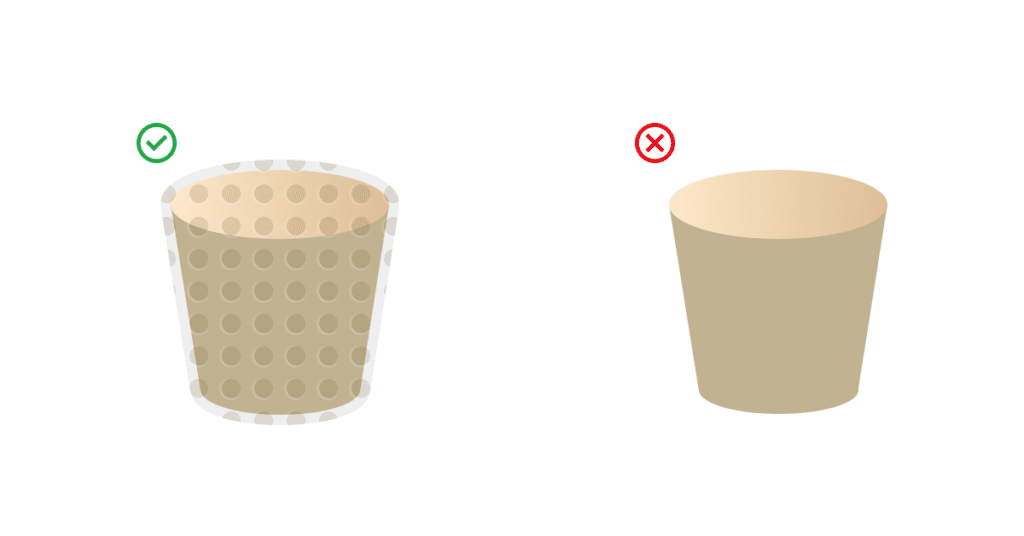
- Do: Individually pack each item
- Do not: Pack over one item together
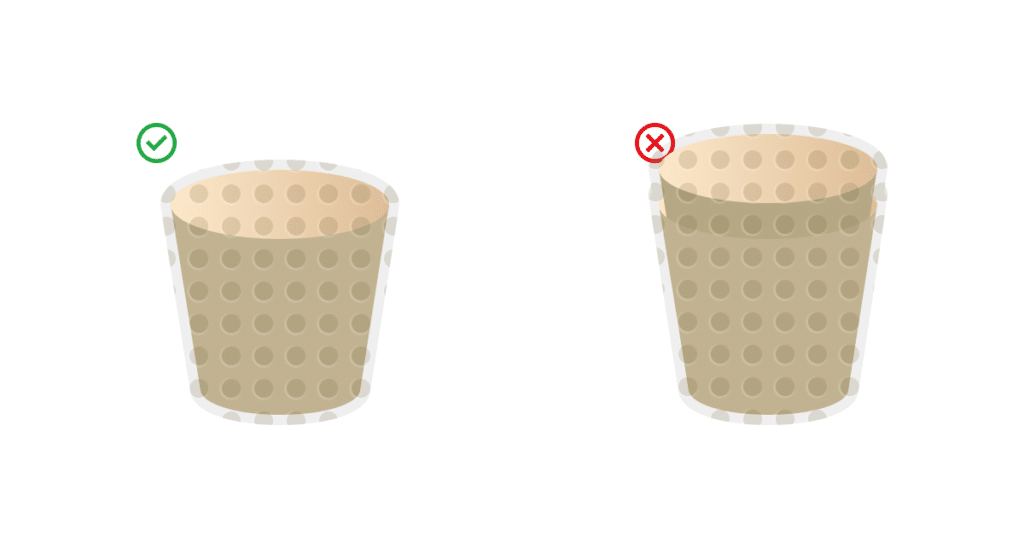
Tip: For Sold As Set units (e.g., two glass cups), wrap the cups individually and then pack them together.
Sold As Set
Amazon’s Sold As Set is bundling two or more items for sale (e.g., toothpaste and toothbrush as one set).
1) The requirements for sold as set
- Package material: shrink-wrap, polybag, or box
- Required label: The set must be clearly labeled ‘Sold As Set,’ ‘Ready to ship,’ or ‘This is a set. Do not separate.’
- ASIN: Sets have a unique ASIN
2) How to package
- Do: package the goods together as a set.
- Do not: package items that comprise a set separately.
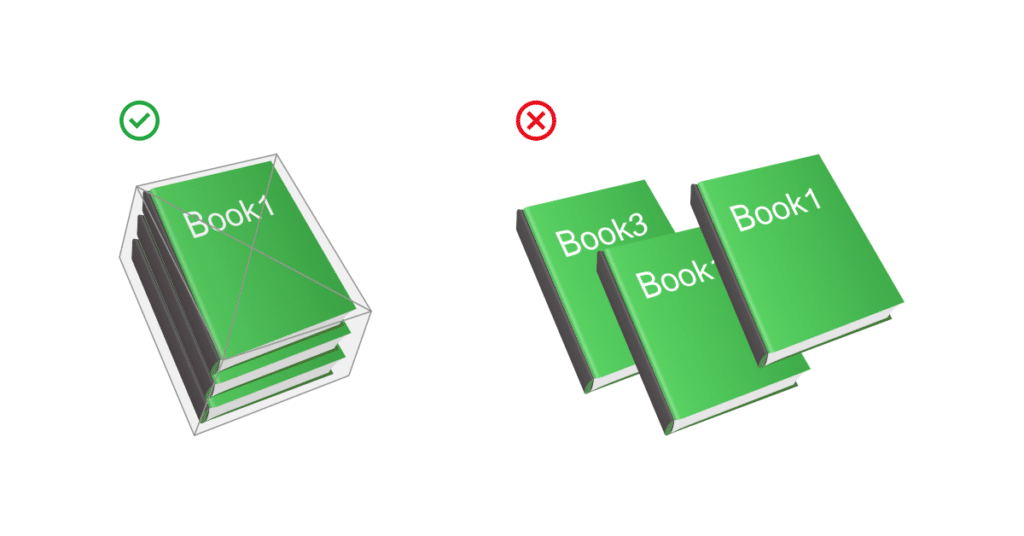
Tips: If items (in the set) have barcodes, hide or cover them.
Product Label Requirements for Amazon FBA
Each unit that you send to Amazon requires a barcode. It assists Amazon in identifying and tracking inventory during the fulfillment process.
When barcode labels are missing, units are mislabeled, or barcodes cannot be scanned, Amazon’s receiving process is slowed down, and extra fees are incurred.
Type of FBA Product Labels
It is necessary to stick to the required product labels after the product packaging is complete. There are four labels:
- FBA product barcode labels: FNSKU or manufacturer barcodes (e.g., UPC, ENA, and JAN), or transparency label, which is used to protect your products and stop counterfeits. Please keep in mind that every unit requires a FNSKU or a manufacturer barcode, and the transparency label is not required
- Sold As Set labels: are only required for Sold As Set products. These labels mean the packages inside cannot be separated.
- Suffocation warning labels: are only required for polybags with an opening of more than 5 inches or 12.5 cm.
- Country of Origin labels: are required by customs services. If your shipments are from overseas, you need the country-of-origin label on your product packaging (e.g., Made in China).
| FNSKU | UPC | Transparency label |
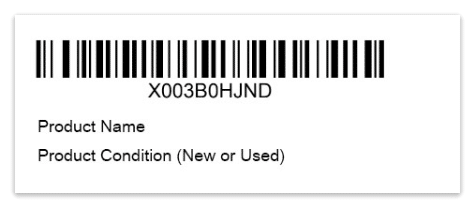 | 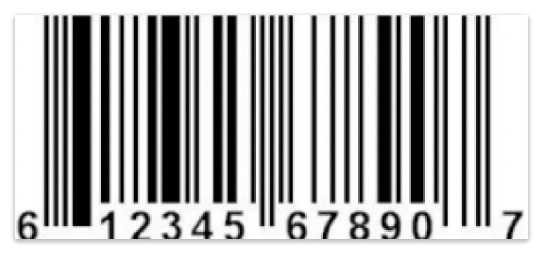 | 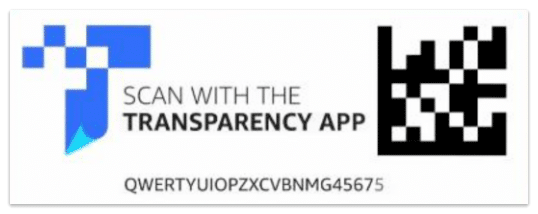 |
| FNSKU | UPC | Transparency label |
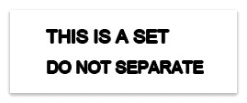 | 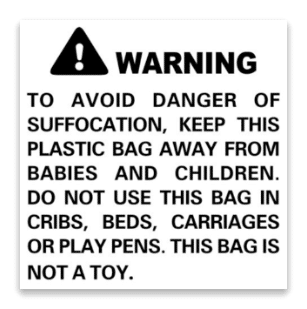 |  |
Plus, how to choose the FBA product barcode labels? FNSKU or manufacture barcodes, which one is better?
The unique nature of FNSKU labels makes them a better choice than manufacturers’ barcodes. In other words, Amazon may fulfill seller A’s order with inventory from seller B’s stock when seller A and B have the same manufacturer’s barcode. In contrast, when you use FNSKU barcodes, this problem cannot occur.
Print FBA Product Labels
Each label must be readable and scannable for two years, according to Amazon’s terms and conditions. Ensure you use labeling material and a printer that guarantees your label will be readable for two years.
Amazon recommends using a direct thermal or laser printer with 300 DPI or more. Do NOT use an INKJET printer. Inkjet printers often produce smeared and blurry images, and labels made with them are hard to read and scan.
After downloading your FNSKU from Amazon, print FNSKU labels using a laser printer. The FNSKU label must comply with the following requirements:
- Label color: white.
- Label size: 1 x 2 inches (2.54 x 5.08 cm) or 2 x 3 inches (5.08 x 7.62 cm).
- Label type: removable adhesive.
The necessary information can be printed on one label. For example, print FNSKU, Sold As Set, Suffocation Warning, and Made in China on one label.
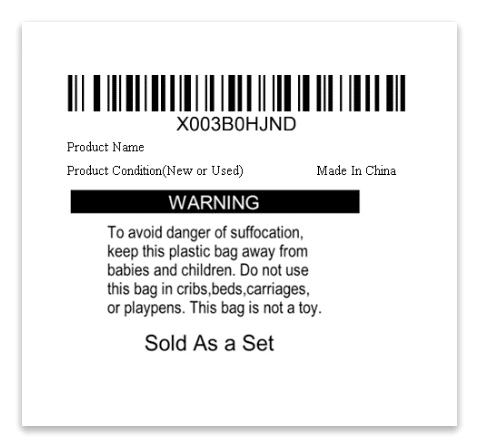
If your supplier does not have a suitable printer, ask them to buy the Amazon label printing service on 1688 or Taobao (Chinese shopping platforms). The service is cost-effective.
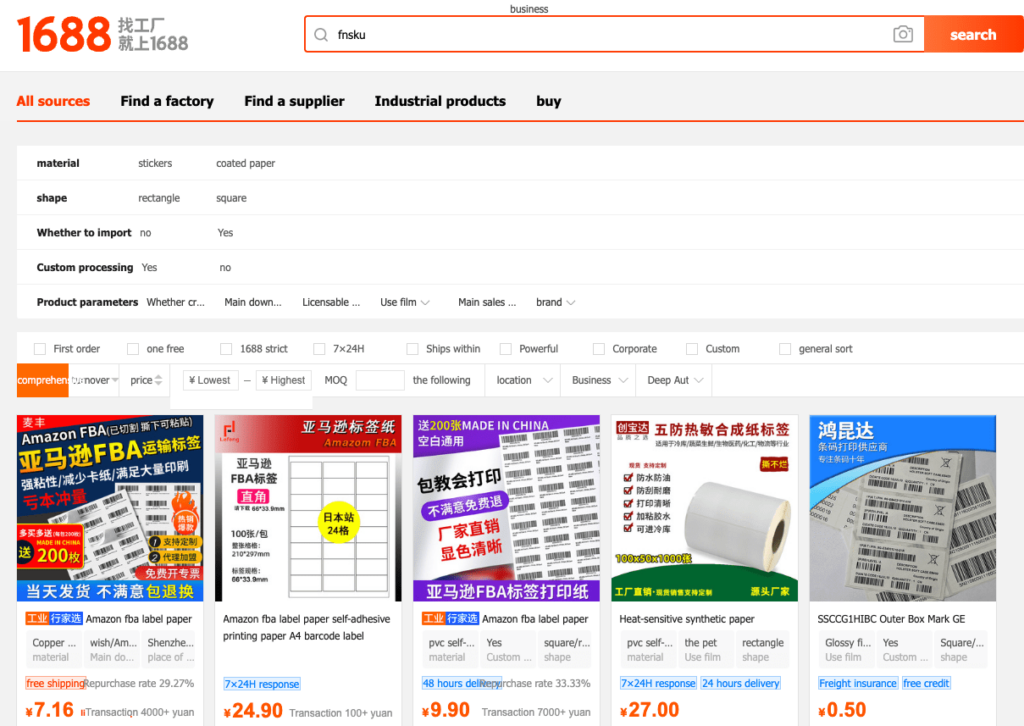
Tips: If a product is mass-produced, the FNSKU or manufacturer barcode can be printed on the product box as well.
Label FBA Products
Labels can be attached to a unit or its packaging. We recommend sticking labels to product packaging.
1) FBA label requirements
- Clear: Use clear labels with no ink or other smudge; they must be readable and scannable
- Quality: Use high-quality labels. Don’t use poor-quality labels. (e.g., label are printed by A4 paper)
- Quantity: Each unit must have an FNSKU label. And whether other labels (such as Sold As Set, Suffocation Warning) are required depends on the units category and their package detail
2) How to label
- Do: Use the correct label that must match the unit
- Do Not: Use an incorrect label that doesn’t match the unit
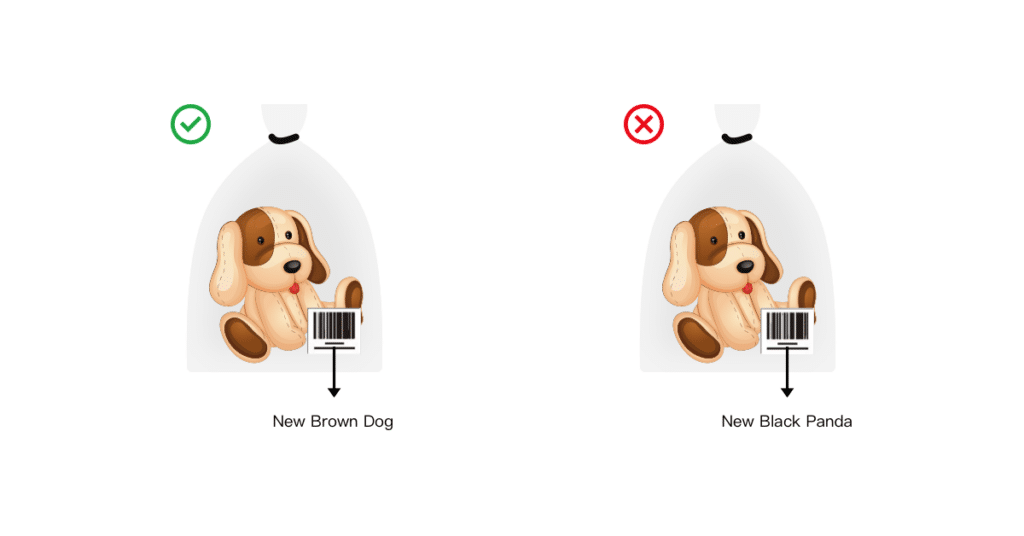
- Do: Stick the label on an accessible and scannable flat surface
- Do Not: Stick the label in an inaccessible or unscannable place
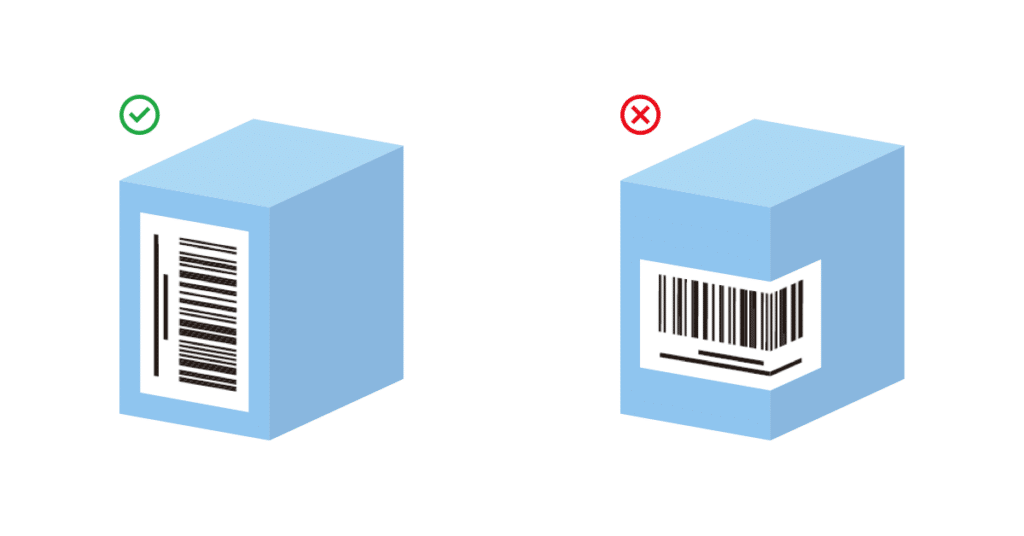
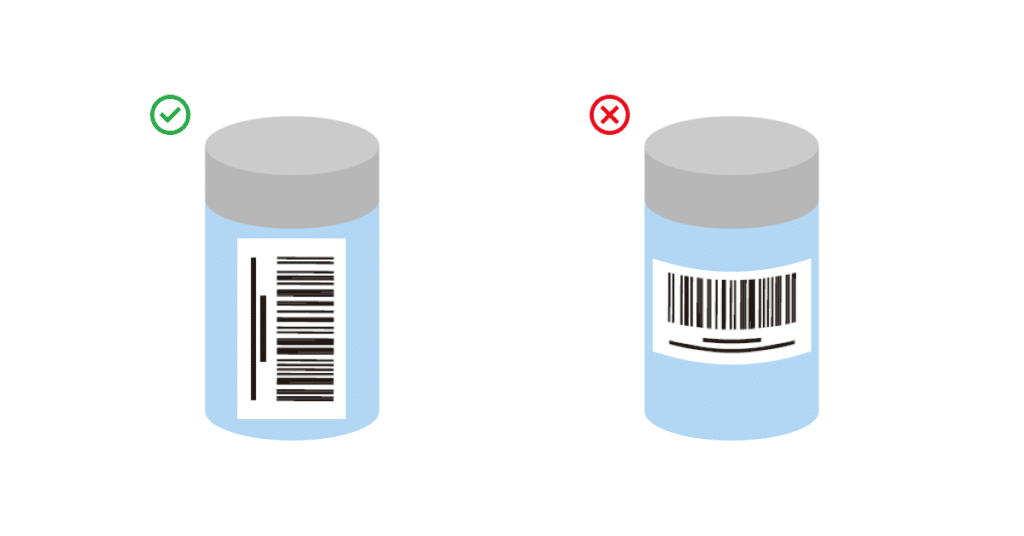
- Do: Attach the label on a blank space
- Do Not: Cover the unit’s critical information, such as product name or raw material
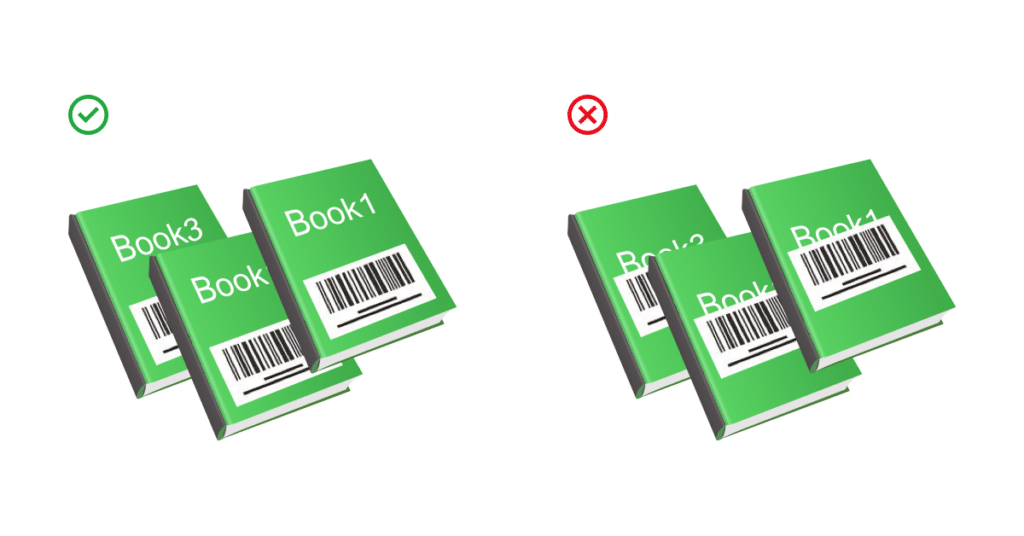
Amazon FBA Shipping Box Packaging & Labeling Requirements
To ensure security during transportation, you must put the packaged products into shipping boxes. Then attach the required labels to the shipping boxes.
Shipping Box Package Requirements for Amazon FBA
It is also important to choose suitable shipping boxes and pack them properly.
Shipping Boxes Requirements
Most Amazon sellers use shipping boxes (corrugated cardboard boxes) to transport their shipments to Amazon.
1) Types of shipping boxes
Generally, the strength of shipping boxes (corrugated carton boxes) is determined by their thickness (single face, single wall and double wall) and flutes (A, B, C, and E flutes).
| Single Face | Single Wall | Double Wall |
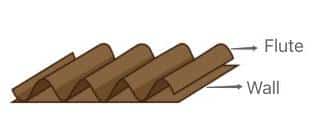 | 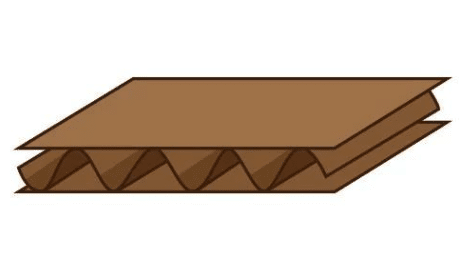 | 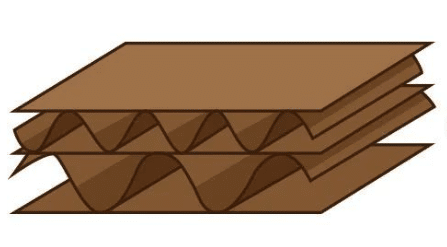 |
According to Amazon, they accept four types of shipping boxes:
- Regular slotted cartons. These are standard corrugated cardboard boxes with a single wall
- Corrugated carton boxes with a B flute are used for heavier items.
- Corrugated carton boxes that have passed the ECT-32 test (edge crush test)
- Corrugated carton boxes that have passed the Mullen test (200 lbs per sq. inch)
Tip: Corrugated carton boxes with a single wall are usually used to deliver regular shipments, and corrugated cartons with a double wall are used for fragile items.
2) Design of shipping boxes
In designing shipping boxes for your Amazon products, consider adding a shipping mark and a dashed box.
Firstly, in the dashed box, indicate the location of the shipment label for your supplier.
Secondly, shipping labels make it easier for people to identify and handle goods properly. Shipping labels usually contain the following:
- QTY (quantity)
- N.W. (net weight)
- G.W. (gross weight)
- SPECS/MEAS (box size)
- C/NO (box number)
- Country of origin
Tip: Add FNSKU and SKU to the shipping mark. That helps your freight forwarder check the goods quickly. The last four digits of the FNSKU can be put on the shipping label if you are concerned about revealing product information.
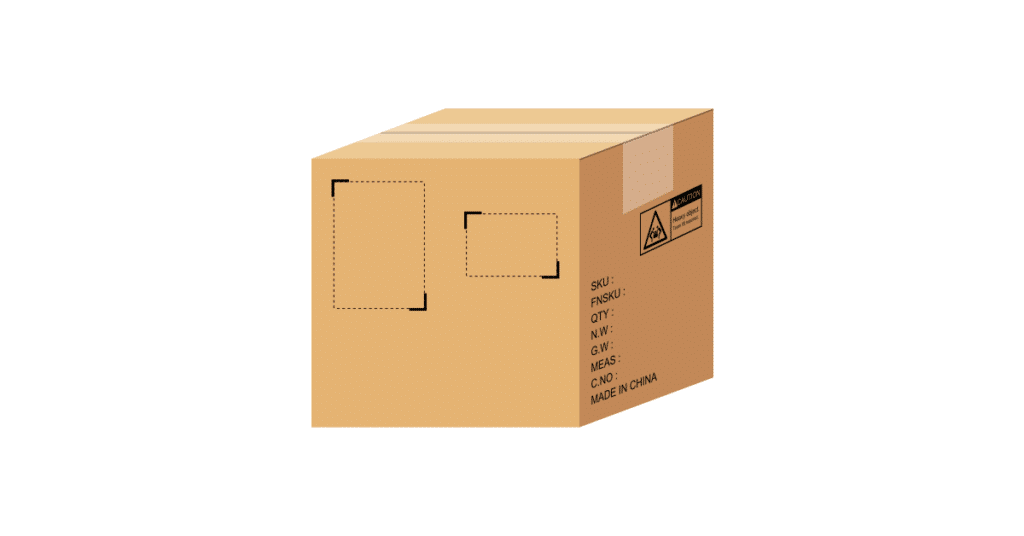
3) The accepted dimensions & weight of shipping boxes
Generally speaking, each side of the shipping box cannot exceed 25 inches (63.5 cm). The limit can be broken when a shipping box contains an oversized unit longer than 25 inches.
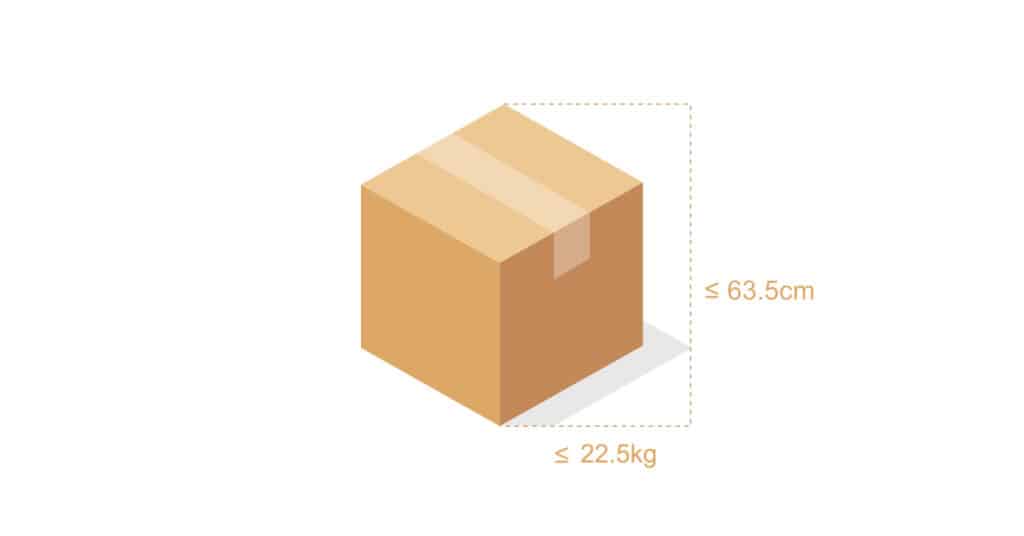
Here are more details:
- Standard weight: Do not exceed 50 lbs. (22.5 kg). However, if the shipping box contains jewelry or watches, it cannot weigh more than 40 lbs. (18 kg).
- Special weight: A shipping box containing a single unit can exceed 50 lbs. (22.5 kg). Plus, a ‘Team Lift’ label must be applied to the top and sides of the shipping box if it weighs more than 50 lbs. And a ‘Mech Lift’ label must be applied to the top and sides of the box if it weighs more than 100 lbs. (45kg).
Tip: The ideal weight for a shipping box is over 25 lbs (12 kg) when the carrier is UPS. This is because UPS has a minimum weight charge of 25 lbs.
4) Packing material
If there is space in the shipping box, you must use an appropriate packing material to fill it. For Amazon FBA, not all packing materials are accepted.
Amazon accepts:
- Full sheets of paper
- Bubble wrap
- Polyethylene foam sheeting
Amazon does not accept the following:
- Foam strips
- Crinkle wrap
- Shredded paper
- Styrofoam
- Thermocol chips
- All types of packing peanuts
Pack FBA Shipping Box
Properly packing your shipment is critical so it can reach Amazon warehouses safely.
1) FBA shipping box packing requirements
- Main packing materials: Use suitable boxes & packing materials of high quality; Don’t use pallet-sized boxes or poor-quality shipping boxes.
- Other packing materials: Cushions, strong transparent shipping tape, safety knives with covered blades
2) How to pack the shipping box
- Do: Place two inches of cushion between the inside of the shipping box and the product (especially for fragile products.)
- Do Not: Leave space inside the box

- Do: Remove or cover all old shipment labels when reusing a shipping box
- Do Not: Reuse a shipping box with the previous shipment labels
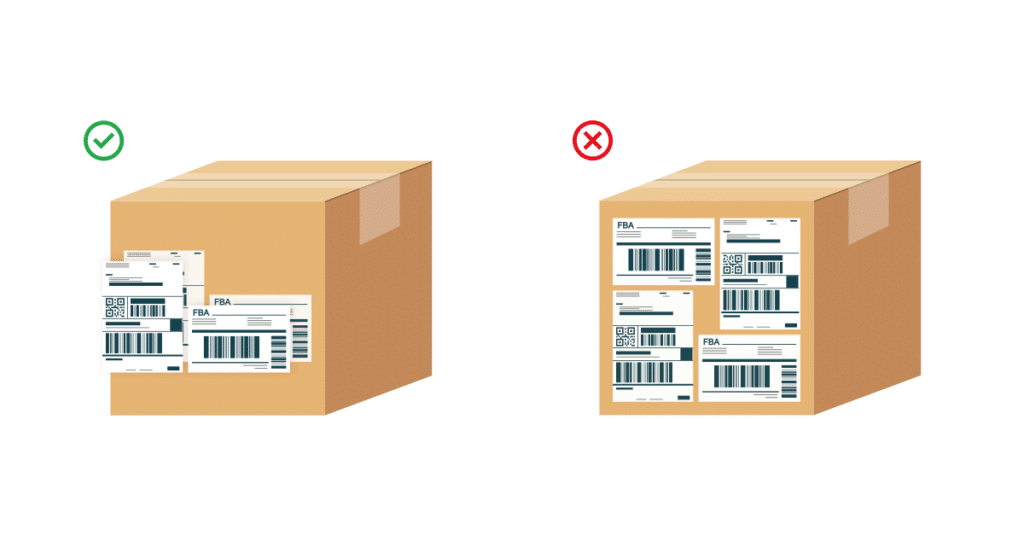
- Do: The shipment label and carrier label away from the packing tape
- Do Not: The packing tape covers the shipment label and carrier label
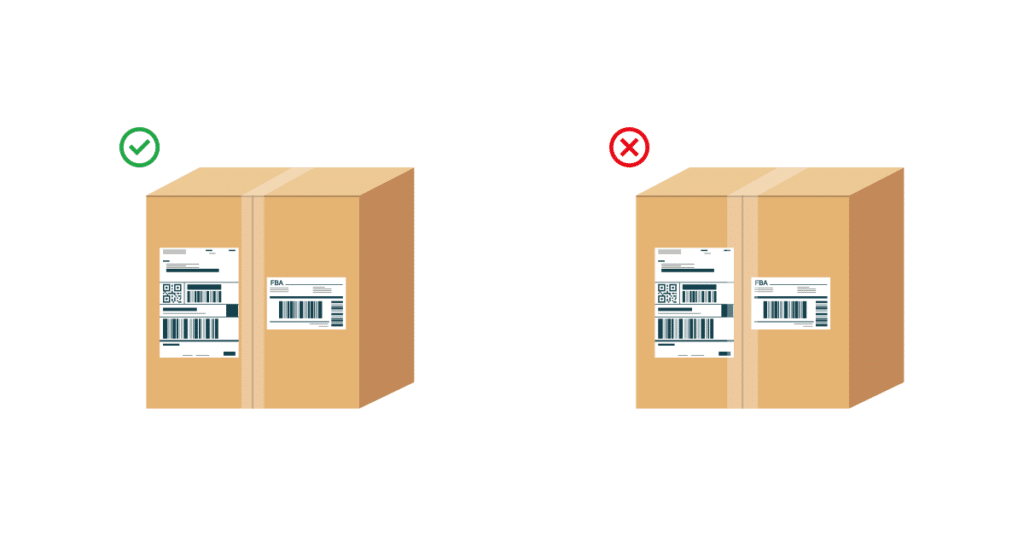
Tip: Once you have packed your box, shake it gently. When shaken, the contents should not move
Shipping Box Label Requirements for Amazon FBA
Each box must have a unique shipment label, known as the FBA Box ID label. These help Amazon quickly identify shipments and inform sellers when their shipments have arrived at Amazon warehouses.
Types of FBA Shipping Box Labels
There are four kinds of labels:
- Shipment labels (FBA Box ID labels): are unique labels required for every box
- Carrier labels: are DHL, UPS, FedEx, or other carrier. And also are required for every box
- Team lift labels: are required when the weight of the box is over 50 lbs or 22.5 kg.
- Mech lift labels: are required when the weight of the box is over 100 lbs or 45 kg.
- Country of origin labels: are required by customs. If your shipments are from overseas, you must have a country of origin label on the shipping box. (e.g., Made in China)
| FBA Box ID Label | Carrier Label |
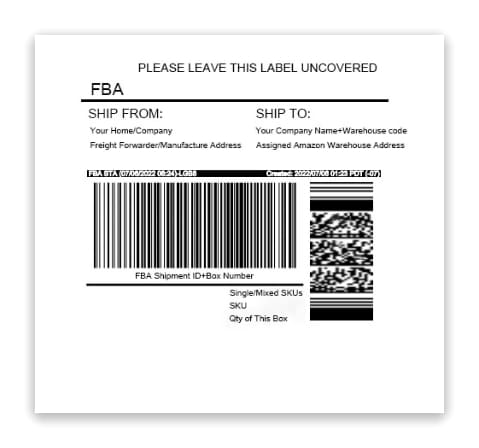 | 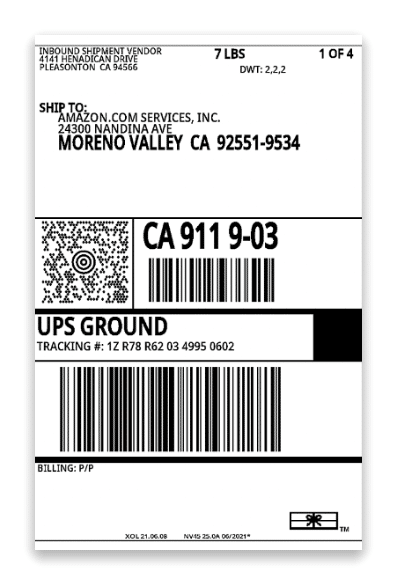 |
| Team Lift | Mech Lift | Country of Oringin |
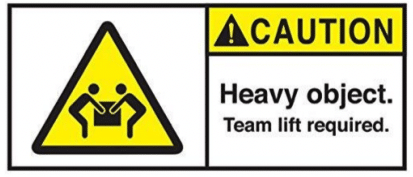 | 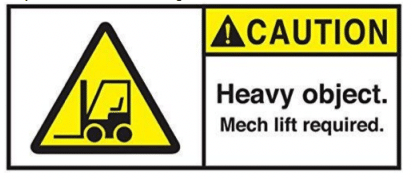 |  |
Print FBA Shipping Box Labels
Download the shipment labels and shipping carrier labels from Amazon. Here are the requirements for shipment labels and carrier labels:
- Label color: white.
- Label size: recommended 4 x 6 inches (10.16 x 15.24 cm).
- Label type: removable adhesive.
Tips: If your shipments are from overseas, the country of origin (e.g., Made in China) can be added to the shipment label.
Other labels can be printed in the appropriate size according to the box size. Ensure you use removable adhesive labels.
Label FBA Shipping Box
1) FBA shipping box label requirements
- Clear: Use clear labels with no ink or other smudges; they must be readable and scannable
- Quality: Use good quality labels. Don’t use poor-quality labels made of A4 paper.
- Quantity: Each unit must have a shipment label and carrier label. Other labels are required depending on the shipping box’s weight and shipment details.
2) How to label
- Do: Use the correct label, ensuring it matches the contents of the shipping box
- Do Not: Use the incorrect label that doesn’t match the contents of the shipping box
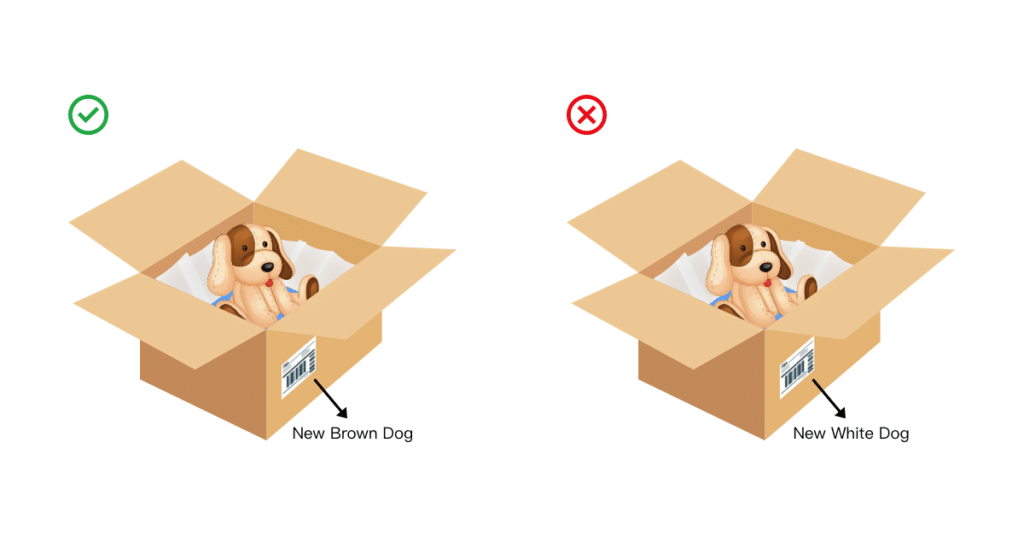
- Do: Stick the label 2cm away from the edge of the box
- Do Not: Stick the label on the box’s edge or corner
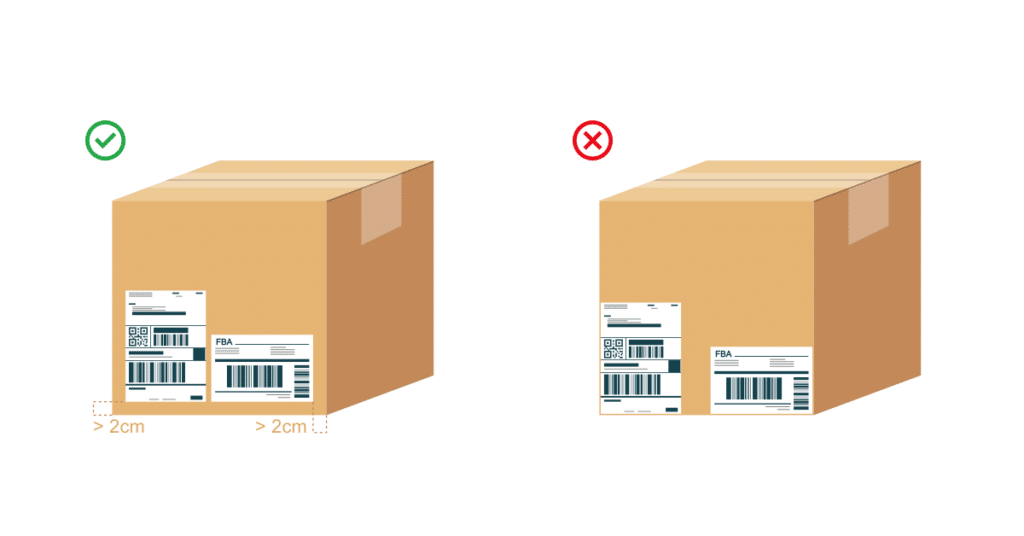
- Do: Stick the label away from the box’s seam
- Do Not: Stick the label on the box’s seam
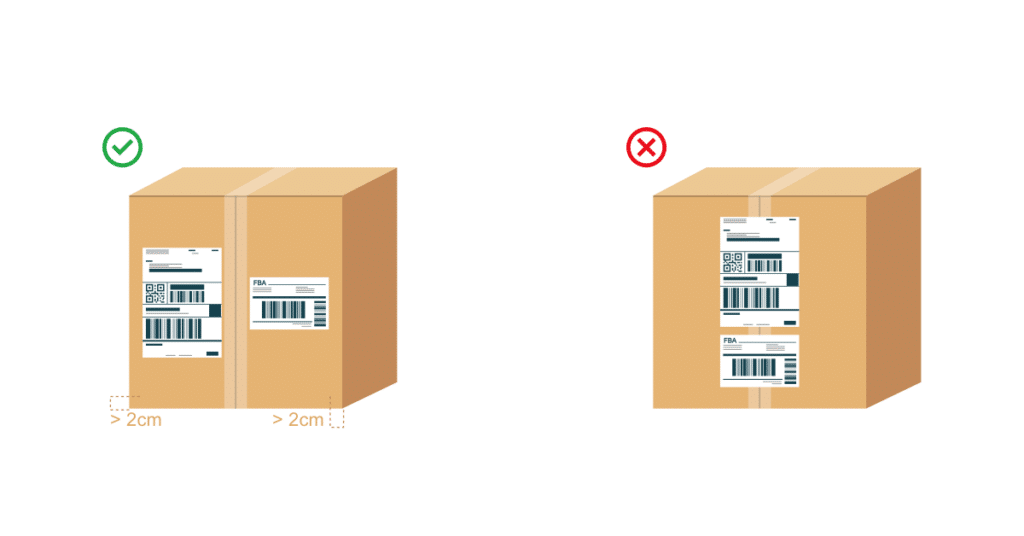
Amazon Shipment Packing & Labeling Requirements
Shipping methods influence shipment packaging. Here are three shipping methods to Amazon fulfillment centers:
- Small parcel deliveries (SPDs): Units are packed in individual boxes for delivery
- Less than truckload (LTL): Individual boxes are combined on pallets for delivery
- Full truckload (FTL): Individual boxes are combined on pallets for delivery
A box is required regardless of whether SPD, LTL, or FTL sends the shipment. If you use SPD to deliver shipments, you can only focus on the last part. But if you use LTL or FTL, you need to pay attention to this part.
Pallet Packing Requirements for Amazon FBA
Amazon has some requirements for pallets to ensure security during transportation and reception.
FBA Pallet requirements
- Grade: use a GMA standard B Grade pallet to deliver most shipments. Use a GMA 1A Grade pallet to ship grocery products. Use GMA 1A and 1B Grade pallets to ship health, personal care, and beauty products.
- Dimensions: use a 40 x 48 inch (101.6 x 122 cm) wooden pallet with 4-way access. If your shipments are larger than 40 x 48 inches, use a suitable size pallet.
- Quality: use pallets that are in good condition.
- Maximum pallet weight: 1,500 lbs or 680 kg
- Maximum pallet height: 72 inches or 182.5 cm for single pallets (unless a single unit exceeds this height); 100 inches or 254 cm for stackable pallets (50 inches or 127 cm per pallet).
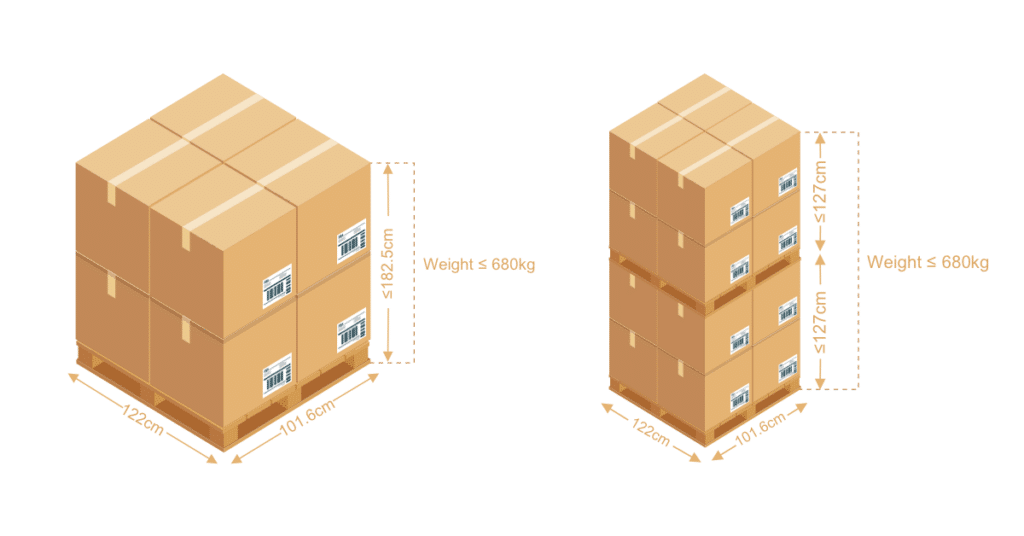
How to Build FBA Pallets
- Do: Place the heaviest boxes on the bottom of the pallet
- Do Not: Place the lightest boxes on the bottom of the pallet
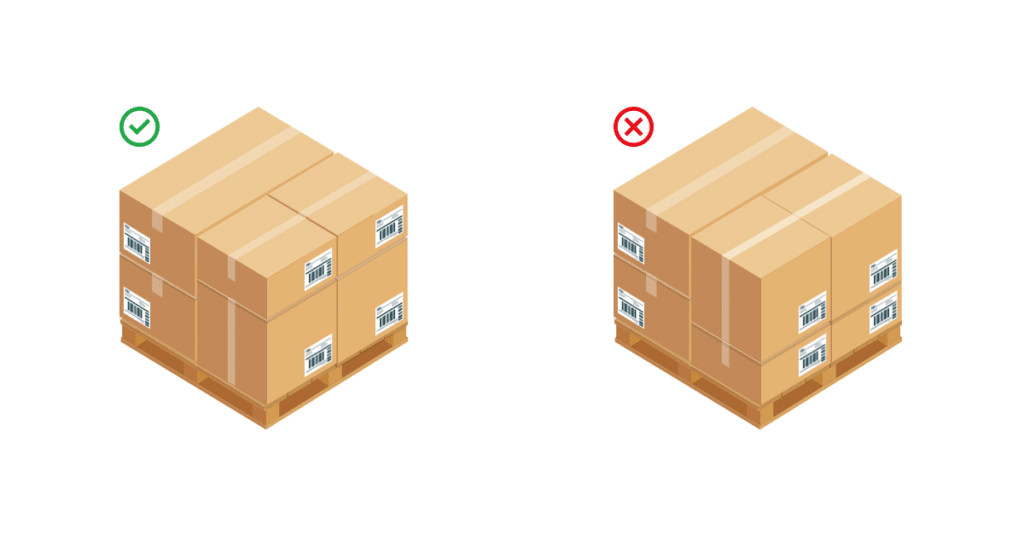
- Do: Ensure the labeled side of the shipping boxes faces outward
- Do Not: Place the labeled side of the shipping boxes facing inward
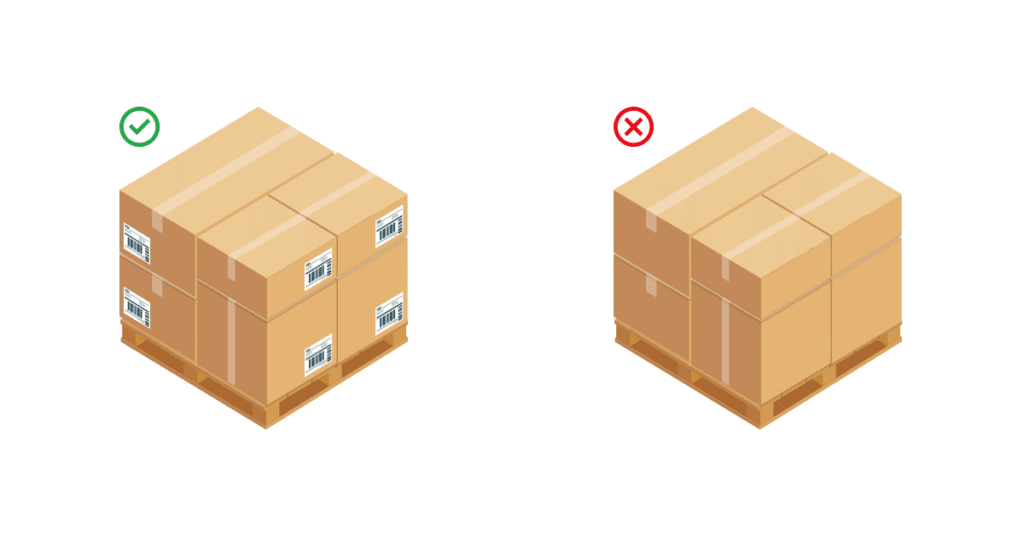
- Do: Ensure your boxes’ dimensions are suitable for the pallet
- Do Not: The contents overhang the pallet edge more than 2.5cm
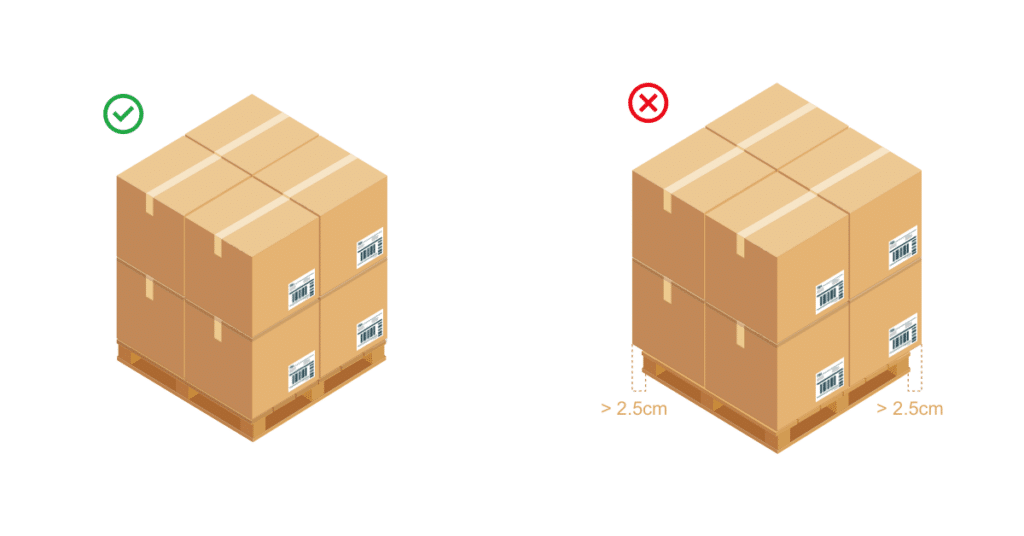
- Do: Use clear plastic stretch wrap to wrap from the top of the stack, down to and including the pallet
- Do Not: Use colored plastic or paper to wrap the pallets
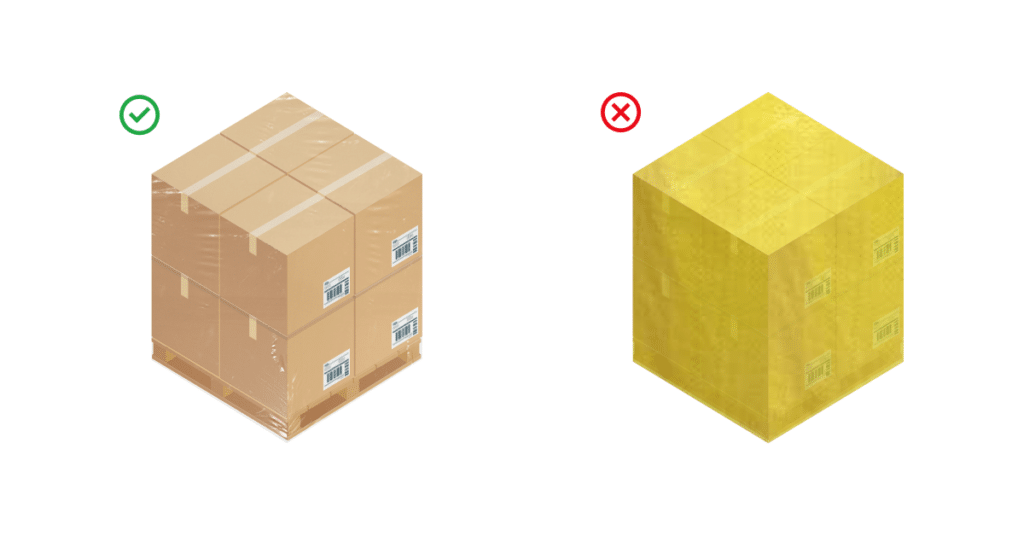
- Do: Use clear plastic stretch wrap to wrap the pallet
- Do Not: Use string or straps to bundle shipping boxes
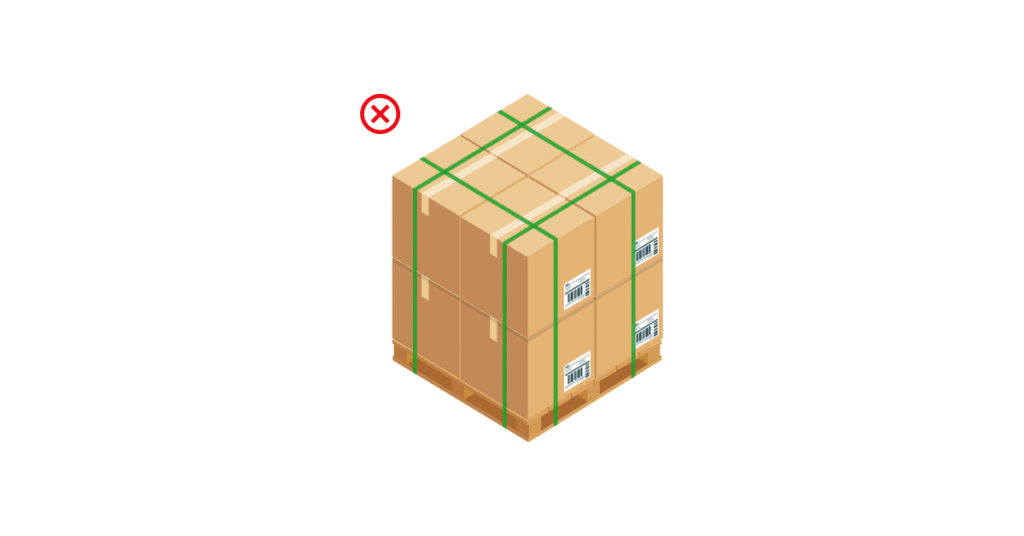
Tip: Do not over-wrap the pallet. That will slow Amazon’s reception of your pallets.
Pallet Label Requirements for Amazon FBA
What labels do you need, and how to label your pallets? Read on and learn more.
Types of FBA Pallet Labels
There are three labels attached to the pallets:
- Pallet label: Every pallet needs four labels (one on each side).
- Do Not Break Stretch Wrap or Do Not Break label: All pallets must be wrapped in plastic with a “Do Not Break Stretch Wrap” or “Do Not Break” notice to the carrier.
- Single ASIN pallet label is required when the pallet contains only one ASIN
| Pallet Label | Do Not Break & Single ASIN Pallet Label |
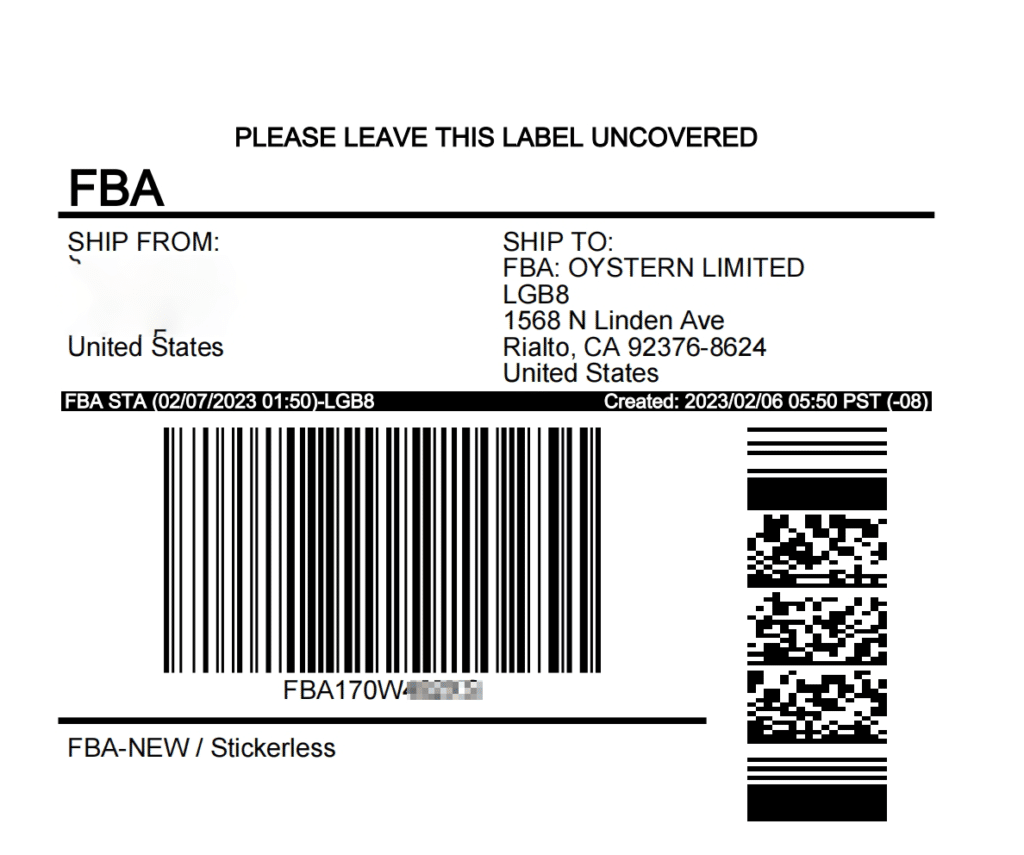 | 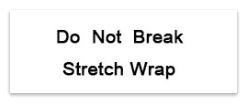 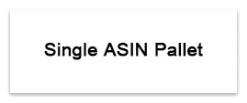 |
Label FBA Pallets
1) FBA pallet label requirements
- Clear: Use clear labels with no ink or other smudges. They must be readable and scannable
- Quality: Use good quality labels. Don’t use poor-quality labels made of A4 paper.
- Quantity: Each pallet must have four pallet labels and Do not Break labels. Whether Single ASIN Pallet labels are required depending on the ASIN of the pallet.
2) How to Label
- Do: Use the correct label which matches the shipment
- Do Not: Use an incorrect label that doesn’t match the shipment
- Do: Attach labels on all four sides of the pallet to the outside of the stretch wrap
- Do Not: Place labels on all four sides of the pallet on the inside of the stretch wrap
- Do: Attach the label to an easily accessible place (on the center of each side)
- Do Not: Attach the label to an inaccessible place (e.g., on the corner)
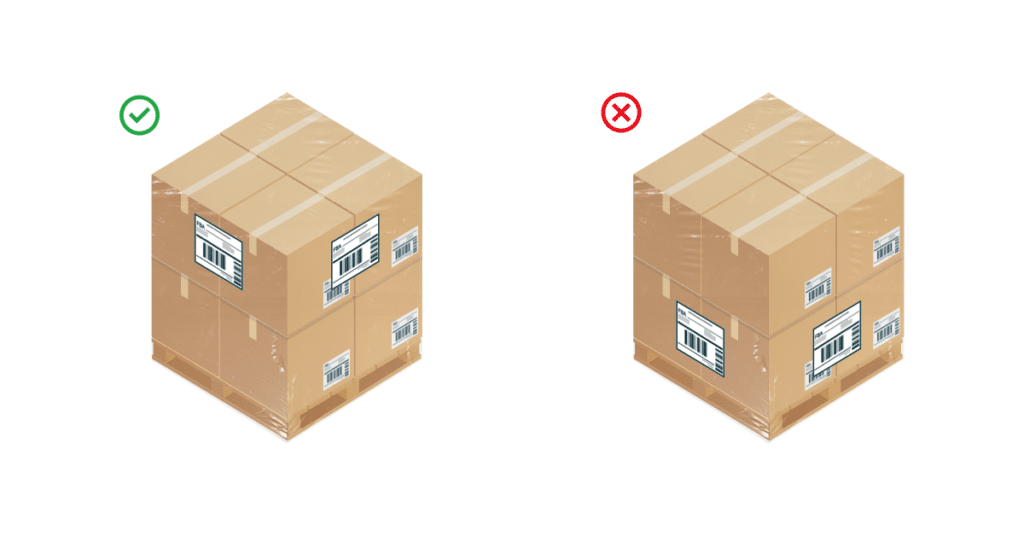
- Do: Have Do Not Break Stretch Wrap Label on the pallet
- Do Not: Don’t have Do Not Break Stretch Wrap label
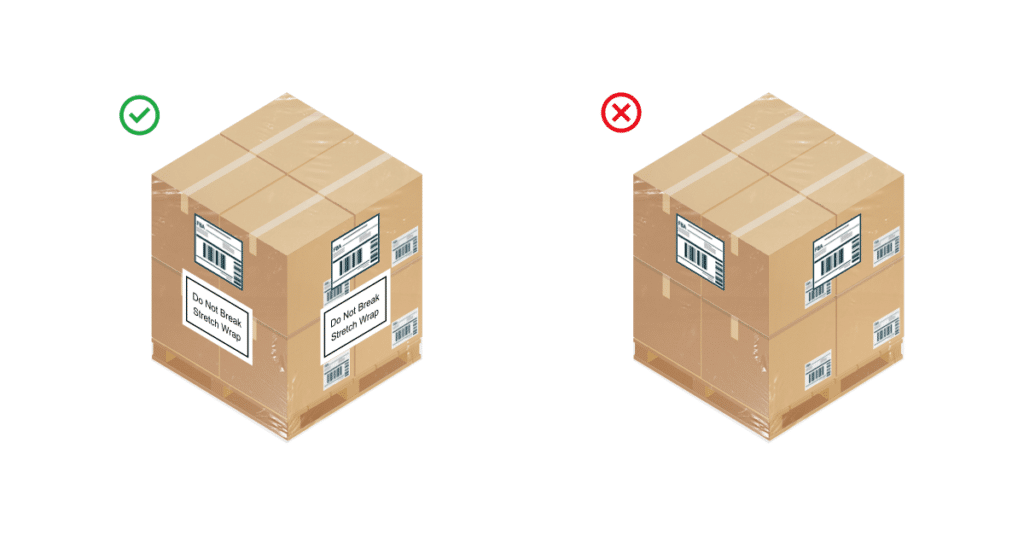
Tip: Use a Single ASIN Pallet label when the pallet contains only one ASIN
Amazon FBA Packaging Requirements Checklist
This is an Amazon FBA packaging checklist to help you check your shipment labels and packing.
1) Are your products adequately packaged?
Generally speaking, all units need to be individually wrapped and sealed. But some products have additional packaging requirements. You must find the relevant packaging requirements to check whether your products are appropriately packaged.
2) Are your products properly labeled?
Each unit must have an FBA barcode label (FNSKU or Manufacturer’s barcode). Whether other labels such as Country of Origin, Suffocation Warning, and Sold as Set are required depends on product details.
3) Are your boxes properly packed?
Each box’s type, weight, and dimension must meet Amazon’s requirements. Generally, box weight cannot exceed 50 lbs. (22.5kg), and the box length cannot exceed 25 inches (63.5 cm).
4) Are your boxes correctly labeled?
Each box must have two labels. Firstly, a unique shipment label that includes shipment I.D., scannable barcode, the ship-from address, and the ship-to address information. The other is a shipping carrier label. Whether other labels such as Country of Origin, Team Lift, Mech Lift labels are required depending on shipment details.
5) Are your pallets adequately packed and correctly labeled?
For shipments shipped via LTL or FTL, a pallet is required. Use a GMA standard B Grade pallet or higher quality one. The pallet weight must be no more than 1500 lbs or 680 kg, and the pallet height must be no more than 72 inches or 182.5 cm.
In addition, each pallet must have two labels. The FBA pallet label and the Do Not Break Stretch Wrap label.
FAQs: Amazon FBA Packaging Requirements
Yes, but we don’t recommend it.
Here’s part of the Amazon statement: “Due to regulatory requirements, all Mylar bags that are not clear or single-colored must be removed from the Amazon store by August 5, 2022.”
This policy is aimed at Mylar bags rather than products packaged in mylar bags. Therefore, mylar bags are allowed to package products. However, some sellers who use mylar bags for packaging products have received a warning from Amazon. To avoid a warning or sanction, use transparent bags for packaging products.
Here are three options:
Use Amazon FBA prep service (safe but expensive)
Use third-party Amazon FBA prep service (safe and cheaper than Amazon)
Use your Amazon freight forwarder prep service (secure and less costly than Amazon)
Choosing a poor FBA preparation service leads to disaster. Your Amazon business will suffer extra fees, or you could even be shut down. Take care when choosing.
The factors you should consider:
Professional: ensure they understand Amazon FBA packaging and shipping requirements.
Experienced: ensure they have focused on providing Amazon FBA preparation services for over three years.
Good reputation: ensure they have good customer reviews.
Good service: ensure the service personnel are responsive and detail-oriented.
Choose a cost-effective service.
Shipments refused by Amazon are a devastating disaster for sellers. However, this will rarely happen if you strictly adhere to Amazon’s packaging and shipping requirements.
Among the most common Amazon rejection reasons are:
1. Failure to use an Amazon-approved shipping carrier, especially in the USA
2. The shipment doesn’t have a shipment label
3. The pallet is overhanging, overhigh, or overweight
4. The shipment was canceled or deleted
5. The shipping plan has expired (over 90 days)
6. The shipment is delivered from overseas to an Amazon center, but the duties or taxes have not been paid
Conclusion
Amazon preparation and packaging are critical. If your suppliers provide improper packaging, your goods must be packaged again before being delivered to Amazon fulfillment centers. More and more time is wasted.
Therefore, your suppliers must start by packaging your products, guaranteeing they will be accepted by Amazon and customs and get to consumers safely and intact. In other words, your supplier must follow all Amazon packaging, customs, and transportation requirements when preparing and packaging products, shipping boxes, and pallets. Then, everything will go smoothly. If you have any questions about Amazon FBA packaging requirements, why not contact the FBABEE professional team, it will give you some useful suggestions.

